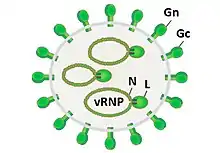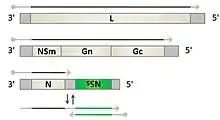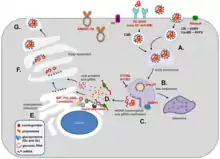Phlebovirus
Phlebovirus is one of twenty genera of the family Phenuiviridae in the order Bunyavirales. The genus contains 66 species.[1] It derives its name from Phlebotominae, the vectors of member species Sandfly fever Naples phlebovirus, which is said to be ultimately from the Greek phlebos, meaning "vein".[2] The proper word for "vein" in ancient Greek is however phleps (φλέψ).[3]
| Phlebovirus | |
|---|---|
 | |
 | |
| Prototypic phlebovirus virion and genome organization. | |
| Virus classification | |
| (unranked): | Virus |
| Realm: | Riboviria |
| Kingdom: | Orthornavirae |
| Phylum: | Negarnaviricota |
| Class: | Ellioviricetes |
| Order: | Bunyavirales |
| Family: | Phenuiviridae |
| Genus: | Phlebovirus |
| Species | |
Virology

Phleboviruses are viruses with a negative-sense RNA genome consisting of three segments. The small segment (S) codes for the viral N protein and a non structural protein, NSs via an ambisense coding strategy. The medium-sized segment (M) codes for a precursor of the viral glycoproteins and non-structural components. The product of the largest segment (L) is the viral RNA-dependent RNA polymerase.[4]
Clinical significance
The following twelve viruses have been linked to disease in humans: Alenquer phlebovirus,[5] Bhanja virus,[6] Candiru phlebovirus,[7] Chagres virus, Sandfly fever Naples phlebovirus, Punta Toro phlebovirus, Rift Valley fever virus, Sicilian phlebovirus, Toscana phlebovirus, Uukuniemi virus, Heartland bandavirus[8] (the first tick-borne phlebovirus known to cause disease in the Western Hemisphere, discovered in 2009), and the Sandfly Turkey virus (discovered in China in 2011).[9] They cause symptoms ranging from short self-limiting fevers, such as pappataci fever, to encephalitis and fatal viral hemorrhagic fever.
Taxonomy
The following species are recognized:[1]
- Adana phlebovirus
- Aguacate phlebovirus
- Alcube phlebovirus
- Alenquer phlebovirus
- Ambe phlebovirus
- Anhanga phlebovirus
- Arumowot phlebovirus
- Bogoria phlebovirus
- Buenaventura phlebovirus
- Bujaru phlebovirus
- Cacao phlebovirus
- Campana phlebovirus
- Candiru phlebovirus
- Chagres phlebovirus
- Cocle phlebovirus
- Corfou phlebovirus
- Dashli phlebovirus
- Durania phlebovirus
- Echarate phlebovirus
- Embossos phlebovirus
- Frijoles phlebovirus
- Gabek phlebovirus
- Gordil phlebovirus
- Icoaraci phlebovirus
- Itaituba phlebovirus
- Itaporanga phlebovirus
- Ixcanal phlebovirus
- Karimabad phlebovirus
- Kiborgoch phlebovirus
- La Gloria phlebovirus
- Lara phlebovirus
- Leticia phlebovirus
- Maldonado phlebovirus
- Massilia phlebovirus
- Medjerda phlebovirus
- Mona Grita phlebovirus
- Mukawa phlebovirus
- Munguba phlebovirus
- Naples phlebovirus
- Nique phlebovirus
- Ntepes phlebovirus
- Odrenisrou phlebovirus
- Oriximina phlebovirus
- Pena Blanca phlebovirus
- Penshurt phlebovirus
- Perkerra phlebovirus
- Punique phlebovirus
- Punta Toro phlebovirus
- Rift Valley fever phlebovirus
- Rio Grande phlebovirus
- Saint Floris phlebovirus
- Salanga phlebovirus
- Salehabad phlebovirus
- Salobo phlabovirus
- Sicilian phlebovirus
- Tapara phlebovirus
- Tehran phlebovirus
- Tico phebovirus
- Toros phlebovirus
- Toscana phlebovirus
- Tres Almendras phlebovirus
- Turuna phlebovirus
- Uriurana phlebovirus
- Urucuri phlebovirus
- Viola phlebovirus
- Zerdali phlebovirus
As of 2015, within the phlebovirus there are four genetic groups of tick-borne phleboviruses: the SFTS group, the Bhanja group, the Uukuniemi group,[10] and the Kaisodi group.[11]
See also
References
- "Virus Taxonomy: 2020 Release". International Committee on Taxonomy of Viruses (ICTV). March 2021. Retrieved 19 May 2021.
- "ICTV 9th Report (2011) Bunyaviridae". International Committee on Taxonomy of Viruses (ICTV). Retrieved 31 January 2019.
Phlebo: refers to phlebotomine vectors of sandfly fever group viruses; Greek phlebos, “vein”.
- Liddell, H.G. & Scott, R. (1940). A Greek-English Lexicon. Revised and augmented throughout by Sir Henry Stuart Jones. With the assistance of Roderick McKenzie. Oxford: Clarendon Press.
- Modrow, Susanne; Falke, Dietrich; Truyen, Uwe; Schätzl, Hermann. Molecular Virology. Springer. p. 460. ISBN 978-3-642-20718-1.
- Travassos da Rosa AP, Tesh RB, Pinheiro FP, Travassos da Rosa JF, Peterson NE (1983). "Characterization of eight new phlebotomus fever serogroup arboviruses (Bunyaviridae: Phlebovirus) from the Amazon region of Brazil". Am. J. Trop. Med. Hyg. 32 (5): 1164–71. doi:10.4269/ajtmh.1983.32.1164. PMID 6312820.
- Vesenjak-Hirjan J, Calisher CH, Beus I. Marton E. First natural clinical human Bhanja virus infection, p 297–301. 1980. In Vesenjak-Hirjan J, Porterfield JS, Arslanagí, c E (ed), Arboviruses in the Mediterranean countries: 6th FEMS Symposium. Fischer, Stuttgart, Germany.
- Palacios, Gustavo; Tesh, Robert; Travassos da Rosa, Amelia; Savji, Nazir; Sze, Wilson; Jain, Komal; Serge, Robert; Guzman, Hilda; Guevara, Carolina; Nunes, Marcio; Nunes-Neto, Joaquim; Kochel, Tadeusz; Hutchinson, Stephen; Vasconcelos, Pedro; Lipkin, Ian (2011). "Characterization of the Candiru antigenic complex (Bunyaviridae: Phlebovirus), a highly diverse and reassorting group of viruses affecting humans in tropical America". Journal of Virology. 85 (8): 3811–20. doi:10.1128/JVI.02275-10. PMC 3126144. PMID 21289119.
- Savage, HM; Godsey, MS; Lambert, A; Panella, NA; Burkhalter, KL; Harmon, JR; Lash, RR; Ashley, DC; Nicholson, WL (2013). "First detection of heartland virus (Bunyaviridae: Phlebovirus) from field collected arthropods". Am. J. Trop. Med. Hyg. 89 (3): 445–52. doi:10.4269/ajtmh.13-0209. PMC 3771279. PMID 23878186.
- Yu, X. J.; Liang, M. F.; Zhang, S. Y.; Liu, Y.; Li, J. D.; Sun, Y. L.; Zhang, L.; Zhang, Q. F.; Popov, V. L.; Li, C.; Qu, J.; Li, Q.; Zhang, Y. P.; Hai, R.; Wu, W.; Wang, Q.; Zhan, F. X.; Wang, X. J.; Kan, B.; Wang, S. W.; Wan, K. L.; Jing, H. Q.; Lu, J. X.; Yin, W. W.; Zhou, H.; Guan, X. H.; Liu, J. F.; Bi, Z. Q.; Liu, G. H.; Ren, J. (2011). "Fever with Thrombocytopenia Associated with a Novel Bunyavirus in China". New England Journal of Medicine. 364 (16): 1523–1532. doi:10.1056/NEJMoa1010095. PMC 3113718. PMID 21410387.
- Matsuno, K; Weisend, C; Kajihara, M; Matysiak, C; Williamson, BN; Simuunza, M; Mweene, AS; Takada, A; Tesh, RB; Ebihara, H (January 2015). "Comprehensive molecular detection of tick-borne phleboviruses leads to the retrospective identification of taxonomically unassigned bunyaviruses and the discovery of a novel member of the genus phlebovirus". J Virol. 89 (1): 594–604. doi:10.1128/JVI.02704-14. PMC 4301164. PMID 25339769.
- Matsuno, K; Weisend, C; Kajihara, M; Matysiak, C; Williamson, BN; Simuunza, M; Mweene, AS; Takada, A; Tesh, RB; Ebihara, H (2015). "Comprehensive molecular detection of tick-borne phleboviruses leads to the retrospective identification of taxonomically unassigned bunyaviruses and the discovery of a novel member of the genus phlebovirus". J Virol. 89 (1): 594–604. doi:10.1128/JVI.02704-14.
External links
- Garry CE, Garry RF (2004). "Proteomics computational analyses suggest that the carboxyl terminal glycoproteins of Bunyaviruses are class II viral fusion protein (beta-penetrenes)". Theor Biol Med Model. 1: 10. doi:10.1186/1742-4682-1-10. PMC 535339. PMID 15544707.
- Course BS335: Virology
- Liu DY, Tesh RB, Travassos Da Rosa AP, Peters CJ, Yang Z, Guzman H, Xiao SY (2003). "Phylogenetic relationships among members of the genus Phlebovirus (Bunyaviridae) based on partial M segment sequence analyses". J. Gen. Virol. 84 (Pt 2): 465–73. doi:10.1099/vir.0.18765-0. PMID 12560581.
- Viralzone: Phlebovirus